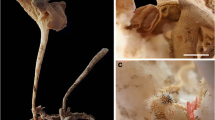Abstract
When echinoids feed on sponges, silicate spicules of the sponge were found to enter their body either by penetration through the wall of the food canal into coelomic cavities or by penetration into skeletal plates and spines. The spicules, which have penetrated into the coelom, obviously evoke a kind of protective answer. They were found to be entangled by clusters of cell remnants, the so-called brown bodies. The brown bodies contain melanin and gather at special sites of the echinoid body; these are the Stewart Organs, the gills and the inner side of the ambulacral plates. Sometimes the silicate spicule becomes surrounded by a calcareous sheath. The length of the sponge spicules makes their removal impossible, so that they are stored. The spicules penetrating into the plates are partly incorporated into the stereom. The four species examined in this study were Asthenosoma ijimai, Araeosoma owstoni, Diadema setosum (collected in Sagami Bay, Japan in 1991) and Hapalosoma gemmiferum (collected in Suruga Bay, Japan in 1991).
Similar content being viewed by others
Literature cited
Bakus, G. J., Abbott, D. P. (1980). Porifera: the sponges. In: Morris, R. H., Abbott, D. P., Haderlie, E. C. (eds.), Intertidal invertebrates of California. Stanford University Press, Stanford, p. 21–39
Birenheide, R. (1992). The sea urchin lantern coelom: a circulatory system. In: Scalera-Liaci, L., Canicatti, C. (eds.) Echinoderm research 1991, Proc. 3rd Colloquium on Echinoderms. Balkema, Rotterdam, p. 67–72
Canicatti, C., D'Ancona, G., Farina-Lipari, E. (1989). The Holothuria polii brown bodies. Boll. Zool. 56: 275–283 (1989)
Cobb, J. L. S., Sneddon, E. (1977). An ultrastructural study of the gills of Echinus esculentus. Cell Tissue Res. 182: 265–274
De Ridder, C., Jangoux, M. (1984). Intracoelomic parasitic Sporozoa in the burrowing spatangoid echinoid Echinocardium cordatum: coelomocyte reaction and formation of brown bodies. Helgoländer Meeresunters. 37: 225–231
De Ridder, C., Lawrence, J. M. (1982). Food and feeding mechanisms: Echinoidea. In: Jangoux, M., Lawrence, J. M. (eds.) Echinoderm nutrition. Balkema, Rotterdam, p. 57–116
Hetzel, H. R. (1963). Studies on holothurian coelomocytes. I. A. survey of coelomocyte types. Biol. Bull. mar. biol. Lab., Woods Hole 125: 289–301
Hetzel, H. R. (1965). Studies on the holothurian coelomocytes: II. The origin of coelomocytes and the formation of brown bodies. Biol. Bull. mar. biol. Lab., Woods Hole 128: 102–111
Humason, G. L. (1979). Animal tissue techniques. Freeman & Co., San Francisco
Meylan, A. (1988). Spongivory in hawksbill turtles: a diet of glass. Science, N.Y. 239: 393–395
Mortensen, T. (1935). A monograph of the Echinoidea I. Reitzel, Copenhagen
Mortensen, T. (1938). On the vegetarian diet of some deep sea echinoids. Annotnes zool. jap. 17: 225–228
Mortensen, T. (1940). A monograph of the echinoidea III(1). Reitzel, Copenhagen
Smith, V. J. (1981). The echinoderms. In: Ratcliffe, N. A., Rowley, A. F. (eds.) Invertebrate blood cells, Vol. 2. Academic Press, London, p. 513–562
Tanita, S. (1989). The demospongiae of Sagami Bay. Biological Laboratory Imperial Household, Tokyo
Vacelet, J., Donadey, C., Froget, C. (1987). The calcium-carbonate spherules of Hemimycale columella (Demosponges, Poecilosclerida) and their taxonomic value. In: Vacelet, J., Buory-Esnault, N. (eds.) Taxonomy of the Porifera from the N. E. Atlantic and Mediterranean Sea, Vol. 13. NATO ASI Series G. Springer Verlag, Berlin, p. 259–274
Author information
Authors and Affiliations
Additional information
Communicated by T. Ikeda, Niigata
Rights and permissions
About this article
Cite this article
Birenheide, R., Amemiya, S. & Motokawa, T. Penetration and storage of sponge spicules in tissues and coelom of spongivorous echinoids. Marine Biology 115, 677–683 (1993). https://doi.org/10.1007/BF00349376
Received:
Accepted:
Issue Date:
DOI: https://doi.org/10.1007/BF00349376




